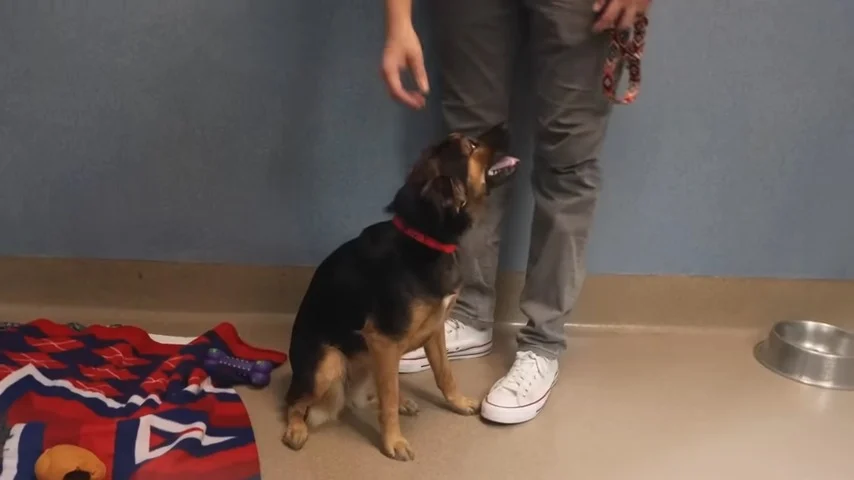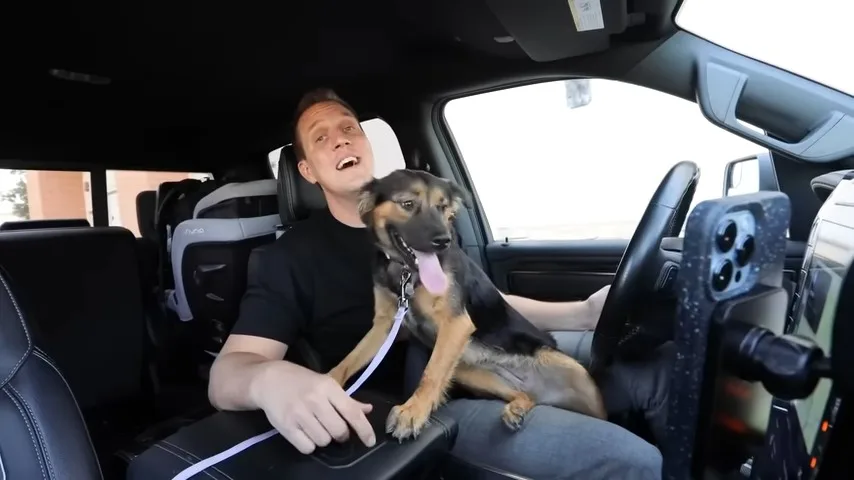When a dog is misbehaving, there is usually a good reason, and none is malicious. They are known to be adorable little troublemakers.
However, that is not an excuse to abandon your dog just because he made a mess a few times.
There are ways you can deal with unwanted behaviour through many positive methods, and none of them involves surrendering your dog to an animal shelter.
In this story, we will talk about an adorable puppy who was abandoned by his previous owners.
Adorable Dog, Penny

When the famous animal rescuer, Rocky Kanaka, from California, first saw Penny arrive in the shelter, he was a bit disappointed to see she was abandoned.
He tried to locate her owners to see if they would be coming back for her, but they didn’t want her anymore.
This was disheartening, as Penny was a lovable dog who just loved being around other people, and didn’t seem like a troublemaker at all.
Luckily, for her, she didn’t have to wait long for new people to come and rescue her from the shelter.

Rocky was a bit skeptical if they would show up, as it was not too uncommon for people to sign up for adoption and then not be there when it was time to take the dog home.
However, he put those worries aside, as there was still time until the process was finalized, and he also wanted to spend some more time with Penny.
Rocky decided that he would take Penny out for a nice cup of Puppuccino. They drove to a nearby Starbucks in California for it and were welcomed by curious staff.
While Penny did not seem too interested in eating, she did enjoy attention from the workers there, as they were all dog lovers.
Penny’s In Good Hands

However, now that their new adventure was over, Rocky and Penny had to wait and see if the new adopters would show up.
Surely enough, those last few hours seemed like they would last forever, but time had finally arrived.
And, as it was meant to be, Penny’s new parents had arrived. Rocky was excited to meet Miguel and Amanda, who just couldn’t wait to see their new dog.
It’s safe to say that their meeting was something truly heartwarming, and it was made apparent to everyone who was there that this beautiful dog finally found his forever home.

To celebrate, they went to their local pet store, and the challenge was simple. Rocky had to buy anything Penny touched.
While it seemed like she only went for the big goods, there were a lot of things in the end. Rocky’s total was $391, which, according to him, was not too bad.
In the end, it was time for them to go their own way. Rocky said goodbye to this sweet dog, and she was now finally heading to her forever home with two of the most amazing people she ever met.
Ever wondered what the world looks like through your furry friend’s eyes? Understanding how dogs see can provide fascinating insights into their behavior and interactions with the environment. As a seasoned dog trainer, you’re constantly observing and interpreting the world from a canine perspective.
From their keen sense of smell to unique color perception, dogs navigate the world in ways that may surprise you. As you delve deeper into the complexities of their vision, you’ll uncover a whole new dimension to your four-legged companion’s daily experiences. Get ready to see the world through a different lens – your dog’s.
Understanding Vision in Dogs
Let’s dive into how your furry companion perceives the world around them through their vision.
1. Visual Acuity
Dogs’ vision is not as sharp as humans’. They see the world in a slightly blurry manner, similar to how we see when a camera is out of focus.
2. Color Vision
While dogs do see colors, their perception is limited compared to humans. They see a range of yellows and blues but struggle with distinguishing between reds and greens.
3. Night Vision
Your canine friend has impressive night vision capabilities. Thanks to a higher number of light-sensitive cells in their eyes, dogs can see better in low-light conditions than we can.
4. Peripheral Vision
Dogs have a wider field of view than humans, allowing them to detect movement and objects from the corners of their eyes more easily.
5. Motion Detection
Your pup’s vision is tuned to detect motion effectively. This ability stems from their evolutionary traits that help them survive in the wild.
Understanding how your dog sees the world can deepen your bond and improve training techniques. By considering their visual abilities, you can create a safer and more engaging environment for your furry companion.
Anatomy of a Dog’s Eye
Let’s take a peek at how a dog’s eye works.
Structure
- Cornea: This serves as a protective outer layer that helps focus light into the eye.
- Lens: The lens behind the cornea further focuses light onto the retina.
- Retina: This contains cells called rods and cones that capture light signals and send them to the brain.
Vision Elements
- Rods: These cells help dogs see well in low light conditions and detect motion efficiently.
- Cones: Dogs have fewer cones than humans, affecting their color perception. They see blues and yellows better than reds and greens.
Tapetum Lucidum
- Reflective Layer: Dogs have this special layer behind the retina that enhances night vision by reflecting incoming light.
Field of Vision
- Peripheral Vision: Dogs have a wider peripheral vision range compared to humans. They are better at detecting moving objects from the side.
Visual Acuity
- Details: Despite having lower visual acuity than humans, dogs compensate with their keen sense of smell and hearing.
Conclusion
Understanding a dog’s eye anatomy gives insights into how they perceive the world. Their unique vision abilities, including night vision and motion detection, contribute to their behavior and interaction with the environment. This knowledge can help you better comprehend your furry companion’s world and strengthen your bond.
Visual Abilities of Dogs
Dogs have unique visual abilities that help them navigate the world around them effectively. These abilities are shaped by their eye structure and provide them with distinct advantages in certain visual tasks. Here are some key points about the visual abilities of dogs:
- Wider Peripheral Vision: Dogs have a wider field of view compared to humans, spanning about 250 degrees. This wide peripheral vision allows them to detect movements and objects on the sides more easily.
- Motion Detection: Dogs are experts at detecting motion due to their high number of rod cells in the retina. Rod cells are sensitive to low light and movement, making dogs adept at tracking moving objects.
- Enhanced Night Vision: Dogs possess a specialized layer in their eyes called the tapetum lucidum, which reflects light within the eye, enhancing their night vision. This reflects light back through the retina, giving them better vision in low-light conditions.
- Limited Color Vision: While dogs have color vision, it is not as vibrant as that of humans. Dogs primarily see in shades of blue and yellow, with limited ability to distinguish between red and green.
- Lower Visual Acuity: Dogs have lower visual acuity compared to humans, meaning they see things with slightly blurred edges. However, their other visual abilities compensate for this, allowing them to excel in tasks that require motion detection and night vision.
Understanding these visual abilities can help you appreciate how your furry companion sees the world and tailor activities to their unique strengths and preferences. Being aware of your dog’s vision capabilities can enhance your interactions and strengthen the bond between you and your loyal friend.
Factors Affecting Dog’s Vision
Eye Anatomy:
- The structure of a dog’s eye plays a crucial role in their vision.
- Components like the cornea, lens, retina, rods, and cones work together to shape their vision capabilities.
Tapetum Lucidum:
- The tapetum lucidum, a reflective layer behind the retina, aids in enhancing a dog’s night vision.
- This structure allows light to reflect back through the retina, improving visibility in low-light conditions.
Color Vision:
- Dogs see colors differently than humans, with a limited color spectrum mainly in shades of blue and yellow.
- Their color vision is less vibrant compared to humans but serves their evolutionary needs well.
Visual Acuity:
- While dogs have lower visual acuity than humans, they compensate with their keen sense of smell and hearing.
- Their vision is more attuned to detecting motion rather than fine details.
Peripheral Vision:
- Dogs possess a wider peripheral vision range compared to humans.
- This wide field of view helps them detect movement and potential threats from various angles.
- Dogs excel in detecting motion due to specialized eye structures and brain processing.
- This ability is vital for their survival instincts and interactions with their environment.
Understanding these factors gives you insights into how your furry companion perceives the world, allowing you to create a more enriching and tailored experience for them.
Comparing Dog’s Vision to Human Vision
When comparing Dog Vision to Human Vision, it’s essential to note that dogs have different visual abilities than humans. While dogs see the world uniquely through their senses and visual perceptions, their vision contrasts with human vision in several key aspects.
- Color Vision:
- Dogs primarily see the world in shades of blue and yellow, whereas humans have a broader color spectrum that includes reds and greens. This means that while dogs can distinguish some colors, their color perception is limited compared to humans.
- Visual Acuity:
- Dogs have lower visual acuity than humans, meaning they see objects as less sharp and clear. However, dogs make up for this with their heightened sense of smell and hearing, which are often more critical for them than sharp vision.
- Night Vision:
- One area where dogs excel is in night vision. Their eyes are adapted to see better in low light conditions, thanks to structures like the tapetum lucidum that reflect light back into the retina. This gives them an advantage over humans in seeing in the dark.
- Peripheral Vision:
- Dogs have a wider peripheral vision range than humans, allowing them to detect movement and potential threats from various angles. This wider field of view is crucial for hunting and survival in the wild.
By understanding these differences between Dog and Human Vision, you can gain insights into how your furry companion perceives the world around them. Adjusting activities and interactions based on your dog’s visual abilities can enhance your bond and ensure a healthy and happy relationship.
Conclusion
Now that you’ve explored how dogs see the world, you can better appreciate their unique visual abilities. From their color perception to night vision prowess, dogs have a fascinating way of experiencing the environment around them. Understanding these differences between human and dog vision can deepen your connection with your furry friend. By tailoring activities to suit their strengths, you can strengthen the bond you share with your canine companion. So next time you’re out with your dog, keep in mind how they view the world – it might just bring you closer together.
Frequently Asked Questions
How do dogs see the world differently from humans?
Dogs see in shades of blue and yellow, with lower visual acuity but excellent night vision and wider peripheral vision range.
Do dogs see colors like humans?
No, dogs do not see colors the way humans do. They mainly see in shades of blue and yellow.
Are dogs good at seeing in the dark?
Yes, dogs excel in night vision due to structures like the tapetum lucidum, which reflect light and enhance visibility in low-light conditions.
How is a dog’s peripheral vision compared to humans?
Dogs have a wider peripheral vision range than humans, allowing them to detect movement and threats from various angles.
[no_toc]

Hey there, I’m Janet Brooks, a dog-loving student from California. I’m all about helping pups in need, especially those without homes. Me and my awesome friends work together to give shelter and love to stray dogs. Oh, and I also write blogs about dogs to share helpful info.